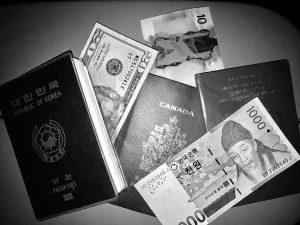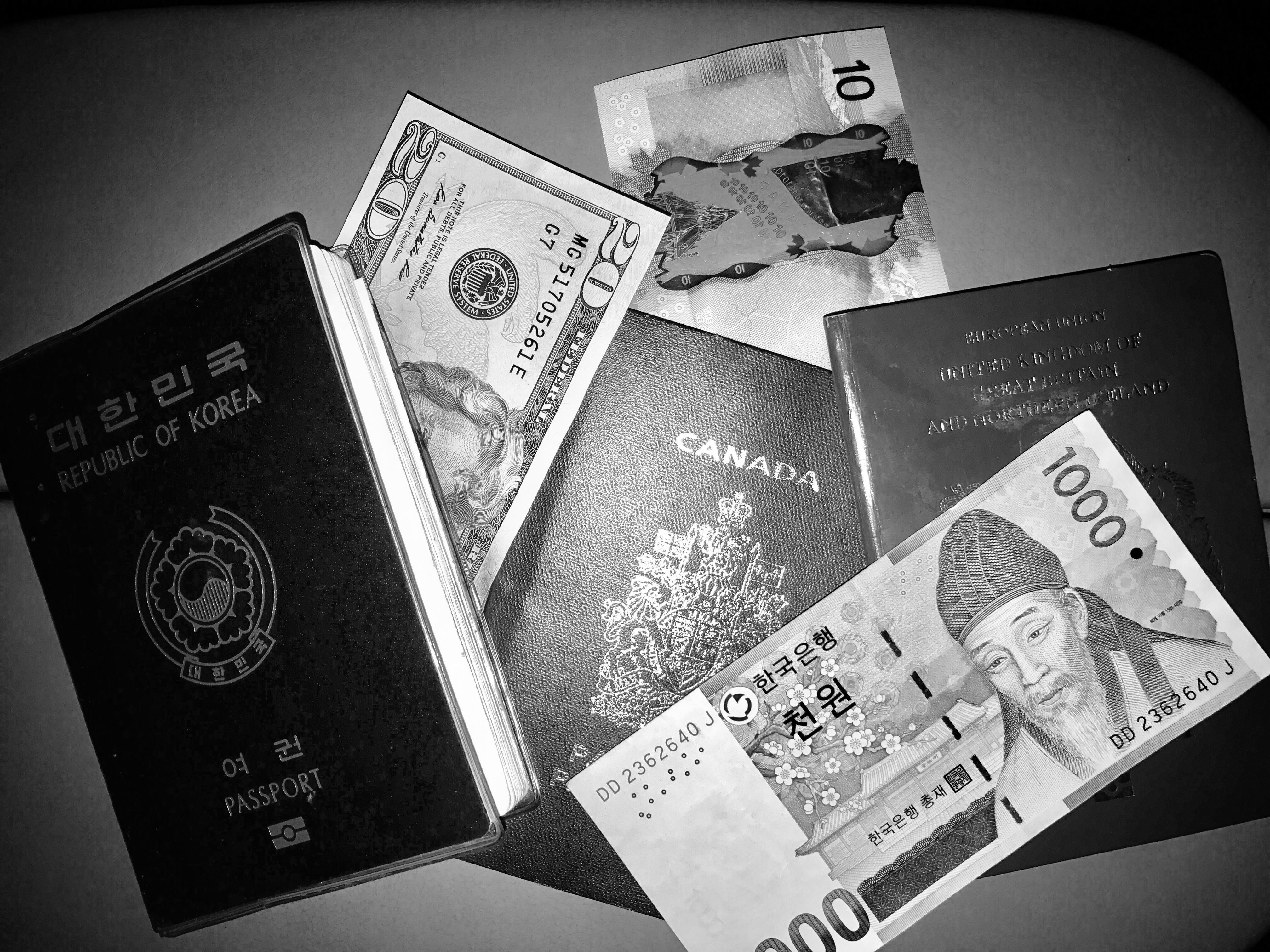Travel and Tourism

This photograph was taken on March 24th, 2017. In this photo there is money and passports from Korea, UK, United States, and Canada. Travel and tourism is a different experience for every one; depending on your location, citizenship, class, etc. Along with these categories comes broader theories or Orientalism, commodities, and citizenship.
The first thing you see when arriving in Vancouver International Airport (YVR) is the Indigenous art, carvings, and totem poles, with a creek and sounds of birds and nature. In this sense, YVR is presenting Vancouver as a multicultural place of harmony, and displaying the culture of Indigenous people. For tourists it’s fascinating to see the culture and art of the Indigenous people, but is shadowed from the real issues in Vancouver. For example, the assimilation and attempted erasure of Indigenous culture in the past, the social, criminal, and medical issues happening in the Downtown Eastside (DTES), and others. However, tourists hardly ever witness or hear about the DTES or Canada’s history with Indigenous people when they are visiting Vancouver.
Stereotypes, both positive and negative, that we have about certain travel destinations can cause us to feel threatened or safe based off of a certain representation. In Vancouver, the DTES has been described as “unsafe” or “dangerous” through representations in the media and word of mouth. While the general “Eastside” of Vancouver has been racialized and discriminated against because of class, ethnicity, and location. These specific stereotypes and representations deter many from visiting these areas, and make it harder for those citizens to escape the stereotype. However, Vancouver is just one small city compared to many other racialized and commoditized locations. In this case it is only adequate that we use these stereotypes to describe Orientalist views that coincide with the themes of travel and tourism.
Vancouver is advertised as a place to visit the location of the 2010 Winter Olympics, tour Stanley Park, watch a Canucks game, etc. In the Mahrouse article, she “considers how gendered and racialized imperial dynamics may be perpetuated today through tourism.” The article helps explain that colonialist views shape the ways that agencies produce advertisements. Therefore, it is understandable that the knowledge we enquire about locations and the stereotypes are often created by the travel and tourism industry. Said’s theory of imaged geographies help these companies make profit through our fantasy of the cultures and ideas of these places. These fantasies and images of these locations are part of the Orientalist theory, created by this industry that makes profit off of the racialization and commodification of locals.
Not only do these stereotypes create a larger sample of Orientalism, but because of these stereotypical views that tourists have, it creates a commodification of residents and these tourist locations. In “Not Just (ANY) Body Can be a Citizen”, Alexander explains that women’s bodies are used to sexualize and entice people, specifically men, to visit Trinidad and Tobago and the Bahamas. This article also describes that these ads have “embedded signifiers about appropriate sexuality, about the kind of sexuality that presumably imperils the nation and about the kind of sexuality that promotes citizenship.” Many countries use this fantasy of heterosexual sexuality and exoticism as commodities for capital gain.
This picture symbolizes the amount of inclusion or non-racialized you may be based off of your citizenship. The ability to do and experience certain things, such as travel or tourism, comes with a cost. For those who want to tour and “broaden their horizons” through travel have to have both the social and economic capital to do so. Katherine Clover’s quote perfectly describes this privilege of those not as affected by intersectionality when traveling. “Aside from money, being able to travel safely and easily is still often dependent on privilege. For people with disabilities, any form of travel can pose myriad potential problems. For folks who aren’t white or are visibly LGBTQIA, travel can mean opening oneself up to harassment and even the very real risk of violence.” Overall, it is obvious that there is inequality and racialization in how people are affected by travel and tourism by class, ethnicity, sexual orientation, citizenship, etc.
References
Alexander, M. J. “Not just (any) Body can be a Citizen: The Politics of Law, Sexuality and Postcoloniality in Trinidad and Tobago and the Bahamas.” Feminist Review, no. 48, 1994, pp. 5-23.
Liu, Sikee, and Nicholas Blomley. “Making News and Making Space: Framing Vancouver’s Downtown Eastside: Making News and Making Space.” The Canadian Geographer / Le Géographe canadien, vol. 57, no. 2, 2013, pp. 119-132, doi:10.1111/j.1541-0064.2012.00453.x.
Mahrouse, Gada. “Feel-good tourism: An ethical option for socially-conscious Westerners?.” ACME: An International Journal for Critical Geographies [Online], 10.3 (2011): 372-391. Web. 27 Mar. 2017
